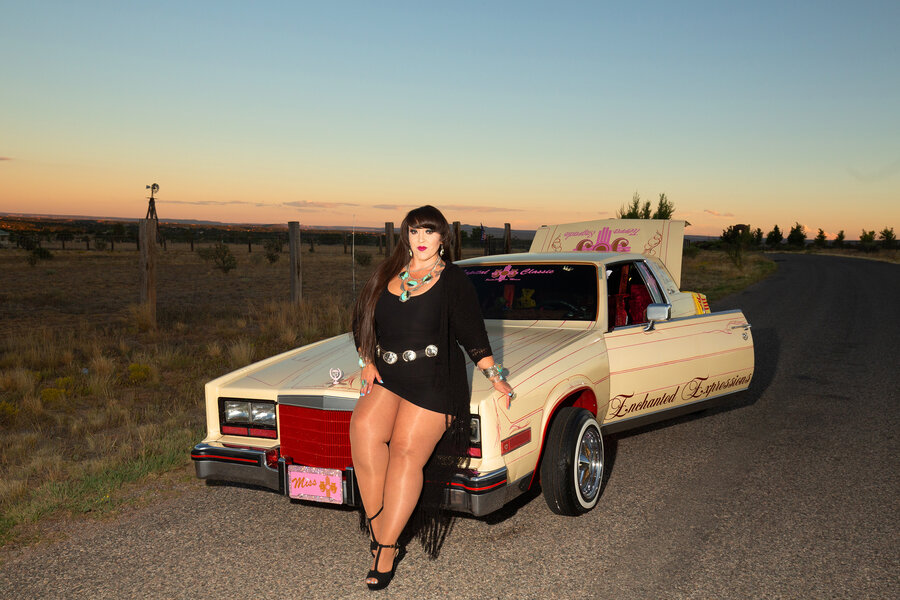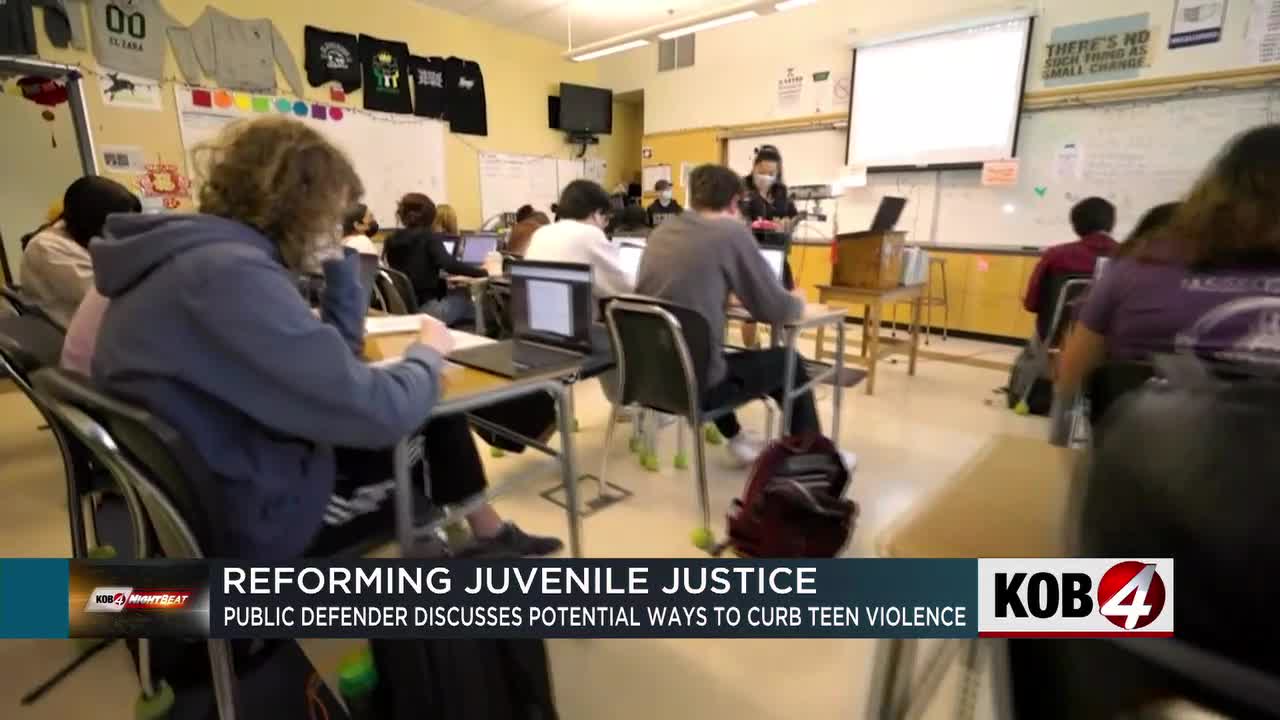New Mexico
Cruising Low ‘n Slow with the Women Shaping New Mexico’s Lowrider Scene

Walk past the Hotel Chimayó, just off the Santa Fe Plaza, and sweep your eyes across my ride: a sleek silver ‘64 Chevy Impala, bathed in the sun, a time capsule commanding the gaze of anyone that lays eyes on her lustrous yet understated carriage. Parked there, she looks refined. Proper, even. But ask nicely, and she’ll drop her back down low, and maybe—with the flip of a switch that controls her hydraulics—bounce it around a little.
She doesn’t have a name, which is unusual for a lowrider, a term that refers both to a car whose suspension has been lowered to inches off the ground, and the person driving it. Most lowriders are personal labors of love, painstakingly put together after spending countless hours and even more cash scavenging for parts. It’s a part of the owner’s family, their story, and the paint job often reflects that, articulating stories of passion, sorrow, pain, and humor, iconographies of faith, struggle, redemption, and community. But my Impala? She’s not only anonymous, but unadorned. She belongs to everyone.
Stay at the Hotel Chimayó and you, too, can ride the passenger seat, rolling past warm, rounded adobe architecture, institutions like the Georgia O’Keeffe Museum, the New Mexico History Museum, and the IAIA Museum of Contemporary Native Arts, plus the vendors selling stunning turquoise pieces around the historic square. The endpoint for the Santa Fe Trail, the Plaza has also been a gathering place for political movements. And it was here in 2016 that Mayor Javier Gonzalez declared May 22 “Lowrider Day.” (“The next best thing to owning a lowrider is admiring someone’s cherry creation,” he said in his proclamation.)
That first Lowrider Day included demos of hoppers, cars outfitted with hydraulics and suspensions capable of not just elevating, leaning, or lowering, but also lifting to towering, near-vertical heights, crashing back down, and bouncing. That last part unfortunately damaged the Plaza’s asphalt, so today’s festivities now include cars suspended halfway up, as if in mid-motion.
“It was only gonna happen for one year,” says Sin Vargas, current Lowrider Day organizer. “But the next year, me, Carlos Munos, and Casey Montoya formed New Mexico Arte de Culture to continue the tradition.”
In addition to Lowrider Day, which changes dates from year to year, you can find car shows online through Vargas’s organization, or just show up at the Plaza on a Friday or Saturday to catch some cruisers in (slow) motion. Come on Good Friday, and it’s mayhem. A lowrider museum is also in the works in Española, New Mexico, but like the cars themselves, it’s taking its time.
That the Heritage Hotel’s whip is a ‘64 Impala isn’t by chance. This is the quintessential lowrider, a 3rd generation model both stretched out and swoopy with an X-type frame that easily lends itself to hydraulic modification. Think of a famous lowrider and you’re probably picturing a ‘64 Impala—including legendary Mexican American lowrider Jesse Valdez’s candy red and pink Gypsy Rose, now in the Petersen Automotive Museum.
But while this car is synonymous with the more recent past, its origins actually date back to Southern California’s post-WWII economic boom. That’s when local vehicle, auto parts, and aircraft manufacturers, among other industries, saw an influx of Chicano war veterans join their ranks, many of them harnessing skills they had learned in the service. And taking their cue from the Anglo-American hot rod craze that swept the country in the 1930s, these newly minted mechanics and machinists decided to put their own twist onto what was becoming a veritable national pastime.
Much like their hot rod-loving counterparts, they wanted their cars flashy. But instead of speed, they went for bajito y suavecito—low and slow. Early lowriders would weigh their cars down with cement or sandbags and cruise the streets as if performing a chromed-out paseo, or stroll, showing off their custom detailing.
Of course, this was the early 1950s, and it wasn’t long before the authorities squashed this overt display of Chicano cultural pride. In 1958, the California Vehicle Code made it illegal to operate any car that’s been modified to sit lower than the bottom of its rims—a law that remains on the books in some cities to this day. Less than a year later, however, a mechanic named Ron Aguirre designed a way to sidestep the restriction. Inspired by the hydraulics planes used for raising and lowering wing flaps, the wily lowrider enthusiast installed switches that easily raised and lowered his car’s chassis, keeping the culture alive through adversity.

We have good ol’ Route 66 to thank for bringing lowriders to northern New Mexico. As New Mexicans set upon Los Angeles utilizing the roadway in search of jobs in the auto industry, lowrider communities sprung up in their wake. The subculture particularly took hold in Chimayó and Española, cities located about 30 miles from Santa Fe and adjacent to the Santa Clara Pueblo, home to the Tewa branch of the Pueblo people. In 1975, Española held New Mexico’s first-ever Lowrider show—the same year War’s very chill, very emblematic “Low Rider” made its debut, a song still played wherever lowriders are found today. Almost 20 years later, MTV declared Española the Lowrider Capital of the World based on lowriders per capita, and in 2018, the city made it official. Here, cars are everything, a fact that very much reflects the struggles of the New Mexicans behind the wheel.
“In my town… cars have been a source of life for people who have been incredibly disenfranchised by multiple layers of colonization”
“In my town, lowriding, and classic and custom cars have been a source of life for people who have been incredibly disenfranchised by multiple layers of colonization,” explains Rose B. Simpson, a mixed-media and performance artist based in Española and hailing from the Santa Clara Pueblo (Kha’po Owingeh).
“I bought my first car when I was 12, drove myself to Driver’s Ed, and got my license at 14,” she continues. “My car was always breaking down because I was broke, but I wanted my freedom, so I worked construction [to] keep my car running and learned to fix it myself. I projected freedom, safety, my aesthetic, and my identity onto my vehicle from a very young age.”
Lowriders have since broken out of the circumstances of their creation. Adopted by hip hop culture in the 1990s, they were amplified by John Singleton’s Boyz in the Hood and songs like Ice Cube’s “It Was A Good Day.” (“If I hit the switch, I can make the ass… drop.”) And for the last few decades, Japan has claimed its own lowriding style. “I was in Japan recently and I was like, ‘These guys are killing it!’” says Simpson. “Which is fascinating because they’re not just making the cars, they’re really embodying that ‘90s lowrider culture that I grew up with and valued.”
To get a feel for the subculture’s deep hold, just have a conversation with Simpson. A Rhode Island School of Design graduate, in her downtime the artist goes hard on heavy metal that rumbles. She’s currently working on her first lowrider, a ‘64 Buick, applying skills she gained while one of the only women enrolled in Northern New Mexico College’s now defunct automotive science program. Describing the lack of women in automotive school, she jokes, “The girl’s bathroom was super, super nice—I should have thrown a cot in there and had a little office because nobody goes in there.”
The Buick may be her first foray into lowriding, but Simpson’s been fixing up cars since that first one in high school. And it’s her stunning, non-lowrider 1985 Chevy El Camino that initially led me to her work. Maria, as she’s called, sports a black-on-black paint job inspired by traditional Tewa pottery made by Maria Martinez of San Ildefonso Pueblo. When Simpson talks about the car she’s affectionate, switching from discussing the technical aspects of buffing paint to describing her as a nurturing vessel in the vein of Nicolas Bouriallard’s Aesthetics of the Everyday.
“She’s a character. I think she’s a piece of me…”
Despite her owner’s dotage, Maria is temperamental, and will sometimes burst into flames if she doesn’t like where she’s being driven. “She’s a character,” says Simpson. “I think she’s a piece of me because, like, if I take her to the grocery store? She’s good, we’re good. But if I take her to a car show, a parade, or she has to go get filmed, she breaks down.”
While all-women car clubs are increasingly popping up around California and muscling their way into New Mexico, lowriding’s machismo culture—like car culture in general—has traditionally been difficult for women to access. When I ask Simpson how she became so confident in her ability to fix up cars, the answer goes back to her mother, a potter.
“My mom built our house, grew all our food, and owns a tractor she doesn’t let anyone drive,” she says. “I never had the feeling that women can’t do something, because of the Indigenous matriarchal women in Santa Clara.”
Though she typically works alone, she has had dreams of an all-women club. But the rising art star with works on display at the Whitney Museum of American Art among other lauded institutions keeps running into one major problem: The women lowriders she knows are just too busy. “I had this idea that I would have a hopper crew,” she says. “That never happened. I was like, ‘Come on, do we have to wait until we’re retired?’ We’re gonna be like these old ladies out there all cackling and shit at the hopping competitions.”
Back at the Hotel Chimayó, you can sip a margarita at the Low ‘n Slow Bar while lowriders congregate under saturated images excerpted from photographer Jack Parsons’ 2005 Low ‘n Slow. A light fixture adorned with glistening hubcaps hangs overhead, below, a diamond-tuck upholstered banquette glitters, orange and red leather doubling as a vintage ride’s bench seat.
But don’t settle for the homage—it’s all about taking one of the real cars out for a spin. One day last spring, I hopped in the hotel’s Impala. My tour guide and driver, Orlie Martinez, turns on War’s “Low Rider” before we set off around the plaza, cruising by windowed storefronts so I can admire our reflection. When Martinez flips a switch, the back drops down, and I can barely see over the dashboard. “I like to roll like this,” he says. “Like a recliner.”
Along the side of the road, tourists pause to ogle. Later, Martinez pulls into a parking lot and, with the help of his car, puts on a show, likening the jerky movements we feel inside to riding a bull. Another switch is flipped and the left side goes up; another, and the right side goes up. He moves it all around and, in lowrider parlance, we’re “dancing.” A crowd gathers and we quickly become the center of attention—and according to Simpson, that’s the whole point.
“It’s soul food, it’s self-love, it’s delicious—it’s when life gets delicious,” says the artist. “Knowing you’re driving something that turns heads, it’s absolutely a beautiful feeling.”
“Oh, you weren’t?” asks Justa Armijo Lovato—a.k.a. Justice Lovato—when I admit that, at first, I wasn’t totally into riding around in Hotel Chimayó’s Impala with all eyes focused on me. “I love it. Heck yeah!”
Granted, everything about Lovato appears destined for the spotlight. From her long silky brown hair to her black dress cinched with a concho belt, bright red lips, and strappy stilettos, she’s not what you’d typically think of when you envision a lowrider. But both Lovato, with her Indigenous, French, and Spanish roots, and her award-winning Cadillac Eldorado, Miss 505, emblazoned with pinstripes, Zia symbols, and the words ‘Tierra Sagrada” (sacred land), are physical embodiments of New Mexico itself.
Like Lovato, Miss 505 glitters: her paint job is a customized cream color with touches of pink and red, her interior plush, with wood paneling and red trim. A logo for Enchanted Expressions, Lovato’s car club, runs along the side, while a Miss 505 decal clings to the back window, creating a magnification effect when the sun streams through. She’s nothing short of a visual feast.
“Throughout our whole state, lowriding has been a reflection of our culture and heritage,” Lovato says. “It’s a representation of our individuality and expression put into our vehicle.”
On her wrists and around her neck are striking turquoise jewelry designed by her friend Adam Fierro, a Native and Spanish jeweler based in Albuquerque. “We are two of a kind, with our Spanish and Native roots and our love and craftsmanship of art,” she says. “His jewelry and my car—it takes individuals of the same mindset to make the endeavor successful.”
Slow-rolling metal is in Lovato’s blood. Her mom Julia, a seventh-generation Santa Fean, had an affinity for cars; her dad Rick is a mechanic. In high school, a boy named Julian Lion turned her head with his lowrider Chevy S10 truck. They’ll be married 25 years this year.
“I was 14, he was 16, and he was in a car club,” she says, recalling the man—and pickup—that changed her life. “That was the very first lowrider to actually take [me on] a ride and really draw me into wanting to build my own.”
She graduated in 2002, and after falling in love with the 1985 Caddy driven by Robert De Niro in Casino, her parents gifted her the all-original 1985 Cadillac Eldorado that would eventually become Miss 505. After a five-year stint in the Navy learning aviation mechanics, she and Julian started building her up.
By then, Lovato was fully invested in lowriding. But when she tried joining a few car clubs, she found that the members were often more interested in what her husband had to say. And so, in 2010, she started her own. Enchanted Expressions is open to everyone, regardless of vehicle type or the person behind the wheel. Today there are 25 members, eight of which are women, including Lovato’s mother.
And she didn’t stop there. It was Justice-style ingenuity that got Miss 505 into 2017’s Lowriders, Hoppers, and Hot Rods: Car Culture of Northern New Mexico at the New Mexico History Museum, cementing her owner’s place in history as the first woman lowrider exhibited in New Mexico history.
These days, the car and driver pair’s reputation precedes them. They serve as ambassadors for lowrider culture in local schools, and the Taos Sheriff’s Department has dubbed her La Reina del Norte (a.k.a. Queen of the North), a title she carries proudly. Walk into the Taos Inn and—if it’s not on loan to a gallery—you’ll see a painting of Lovato and her car by acclaimed artist Tera Muskrat. In Lovato’s home, there’s a room stacked with almost 80 awards. “My whole living room is full because I have so many of them, and it’s such a high achievement for me, especially the Best in Show Awards,” she says. “I don’t want to tuck them away like some people do in their garage—I want to see them every day.”
Awards won’t be Lovato’s only lowriding legacy. Her club continues to inspire future generations. There’s one young enthusiast who routinely swings by to fix up her own sweet ride. “She’s working on a little electric scooter,” she says. “It is so cute.”
Want more Thrillist? Follow us on Instagram, TikTok, Twitter, Facebook, Pinterest, and YouTube.

New Mexico
Public defender discusses potential way to curb teen violence

One attorney with the New Mexico Public Defender’s Office suggests that solution is looking in the wrong direction, and believes more punishment only brings more crime.
ALBUQUERQUE, N.M. – Gov. Michelle Lujan Grisham is bringing state lawmakers back to the Roundhouse this July to hammer out some new public safety legislation. But it does not appear addressing teen violence is on the agenda.
It seems she is focused on some other public safety issues, specifically in the courts. She has acknowledged teen violence is a serious issue, but we’ve yet to see any serious solutions on the table.
When KOB 4 sat down with her earlier this year, she suggested a pilot program requiring teens to participate in some type of meaningful activity outside of schools. But it doesn’t appear that idea has gone anywhere.
Some law enforcement leaders — including the Bernalillo County district attorney — believe it’s time to rework the state’s juvenile justice laws, and demand more accountability from these teen suspects.
But one attorney with the New Mexico Public Defender’s Office suggests that solution is looking in the wrong direction, and believes more punishment only brings more crime.
“Increasing penalties for kids is going to do nothing except for create a career criminal,” said Dennica Torres with the New Mexico Public Defender’s Office.
Torres says it’s important to remember teenage suspects are not adults.
“They don’t have the adult brain, and we really have to treat them like children. They’re very impulsive, they’re very immature, they’re very reactive,” said Torres.
A potentially lethal combination when guns are involved. Torres admits more teens are getting their hands on guns.
“It’s no longer just words or fists, it’s guns,” Torres said. “Unless we get rid of the internet and social media, we’re never gonna get rid of their access to almost anything they could ever want.”
However, she says increasing punishments for teen gun crimes ignores the reason why many teens have guns in the first place.
“A lot of kids are carrying guns because they think other kids are carrying guns. So they carry guns, because they’re afraid. They’re afraid they’re going to encounter somebody that, you know, doesn’t like them, or a bully at school,” said Torres.
It’s a vicious cycle, and Torres says locking those teens up doesn’t solve much.
“The maximum usually is about 30 years. So you incarcerate a child who’s 16, at 46, they’re going to come out, and they’re not going to have any idea how to function in society. They’re just going to turn right back to crime,” Torres said.
Torres believes educational programs – like the violence intervention program — are the best way to tackle teen violence. She says they have to be crafted for the teenage brain.
“It really needs to come from the view of ‘This is what could happen to you, if you decide to carry a gun and use it,’” said Torres. “Because a lot of times they’re going to not necessarily resonate with the victim, but they’re going to resonate with the fact that you’re talking to them about how it can affect their future and their family.”
Torres noted Bernalillo County’s Juvenile Detention Center is full and understaffed. She believes increasing punishments for teen criminals is just throwing gasoline on that fire.
Torres suggests state lawmakers should commit the money and resources to develop a statewide violence education program, and bring it to high schools and middle schools.
New Mexico
Texas man accused of killing New Mexico women and kidnapping an infant faces federal charge

New Mexico
Houston-area man accused of kidnapping New Mexico baby whose mom, another woman were killed

ABILENE, Texas – A Houston-area man is accused of kidnapping a 10-month-old girl whose mother and another woman were found shot and killed in New Mexico, federal officials say. Authorities say the baby later was found in Texas.
According to the U.S. Attorney’s Office for the District of New Mexico, 26-year-old Alek Isaiah Collins, of Manvel, was charged by criminal complaint with interstate kidnapping of a child.
Alek Collins (Photo: Abilene Police Department)
MORE NEWS: Houston judge’s probation practices scrutinized
Police in New Mexico say two 23-year-old women – Samantha Cisneros and Taryn Allen – were found shot to death at a park near Clovis on May 3. Cisneros’s 5-year-old daughter was also reportedly found on the ground with a head injury and was taken to the hospital.
Police discovered that Cisneros also had a 10-month-old daughter, who was not at the scene. An Amber Alert was issued for the girl.
According to federal officials, evidence indicated the potential involvement of a maroon Honda, and witnesses reported that a maroon or red sedan was at the park at around the time of the incident.
According to the U.S. Attorney’s Office, the investigation revealed that Collins had rented a maroon Honda, and GPS data from the vehicle showed it near that park around the estimated time of the homicide. Collins was also allegedly linked to a phone that was in the area of the park around that time.
MORE NEWS: Suspect charged, second suspect sought in robbery-kidnapping case
Federal officials say the car was found at a home in Abilene, Texas, where the vehicle had been remotely disabled after Collins failed to return it to the owner on time.
Officers were preparing to execute a search warrant at the house when an Uber driver pulled up in an SUV and Collins came out of the home with the girl, the U.S. Attorney’s Office says. Collins allegedly put the girl in the backseat and then forced the Uber driver to get out of the vehicle at gunpoint before Collins drove away with the girl.
MORE NEWS: Mississippi triple-murder suspect shot and killed by Arizona trooper
Abilene police were able to bring the vehicle to a stop, arrest Collins and get the girl out of the car, federal officials say.
Authorities say Collins has no relation to the girl and does not have legal custody of her.
Collins appeared before a federal judge in Abilene on Tuesday morning and will remain in the custody of the U.S. Marshals Service pending transfer to New Mexico.
This story was reported from Houston.
-

 Politics1 week ago
Politics1 week agoHouse Dems seeking re-election seemingly reverse course, call on Biden to 'bring order to the southern border'
-

 World1 week ago
World1 week agoStand-in Jose Raul Mulino wins Panama presidential race
-

 News1 week ago
News1 week agoCompass Direct LLC’s 2024 Registration in North Carolina
-
News1 week ago
UCLA to resume in-person classes after Gaza protest crackdown
-

 World1 week ago
World1 week agoTech compliance reports, Newsletter
-

 News1 week ago
News1 week agoColumbia University cancels its main commencement ceremony after weeks of turmoil
-

 News1 week ago
News1 week agoMan, 75, confesses to killing wife in hospital because he couldn’t afford her care, court documents say
-

 World1 week ago
World1 week agoPentagon chief confirms US pause on weapons shipment to Israel




















